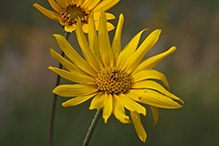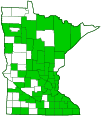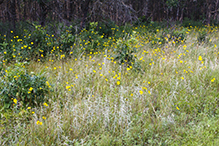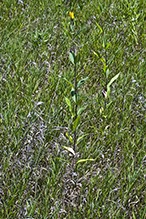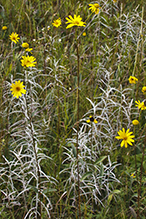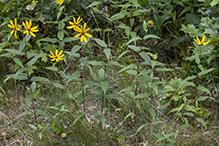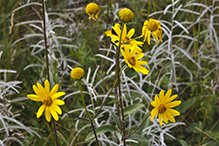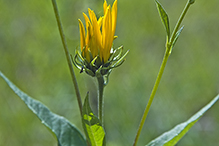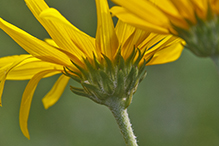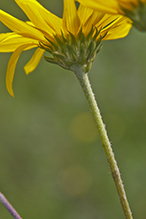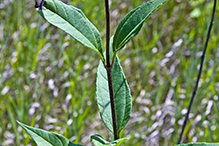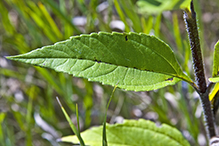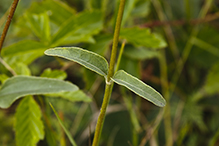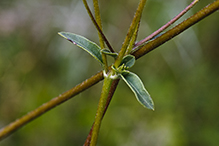hairy sunflower
(Helianthus hirsutus)
Conservation • Description • Habitat • Ecology • Use • Distribution • Taxonomy
Conservation Status |
|
|||||||
| IUCN Red List | not listed |
|||||||
| NatureServe | N4N5 - Apparently Secure to Secure SNR - Unranked |
|||||||
| Minnesota | not listed |
|||||||
Description |
||
Hairy sunflower is an erect, 24″ to 78″ tall, perennial forb that rises on usually a single stem from long-creeping, branched rhizomes. The rhizomes do not produce tubers. The plant sometimes forms dense colonies. The overall appearance is of a slender-stemmed, sometimes spindly plant with one or just a few flower heads. The stems are erect; green, reddish-brown, or tinged with reddish-brown; and unbranched or sparingly branched near the top. They are moderately to densely covered with short, stiff, ascending to spreading hairs. They are sometimes nearly hairless toward the base. There are usually 8 to 20 leaf nodes below the inflorescence. Lower and middle leaves are opposite, uppermost leaves are usually also opposite, sometimes alternate. Lower and middle leaf blades are narrowly lance-shaped to egg-shaped, relatively thick, and flat, not folded longitudinally. They are 2½″ to 7″ long and ⅜″ to 2⅜″ wide, 2 to 7 times as long as wide, becoming gradually smaller as they ascend the stem. They taper to a sharply pointed tip and may be wedge-shaped, rounded, or squared off at the base. The upper surface is rough to the touch with rough to the touch due to a moderate to dense covering of minute to short, stout hairs. The lower surface is moderately to densely covered with somewhat softer, spreading to loosely appressed hairs, and sparsely to moderately covered with stalkless, yellow glands. The margins are flat and finely toothed to almost untoothed. The leaves have 3 main veins, a prominent midvein and a pair of lateral veins that branch off the midvein at or slightly above the base and arch upward. The inflorescence is a solitary head or an open cluster of 2 to 7 flower heads at the end of the stem. The flower heads are on stalks that are ⅜″ to 2″ long. The whorl of bracts at the base of the flower head (involucre) is ⅜″ to 1″ in diameter. The bracts of the involucre are narrowly lance-shaped to lance-shaped and taper to a sharply pointed tip. The tips of the bracts are loosely ascending to spreading or bent backward. The flower heads are 1¾″ to 3½″ wide, the disk is ⅜″ to 1″ in diameter. There are 10 to 15 yellow ray florets and 40 or more yellow disk florets. The fruit is an achene. |
||
Height |
||
24″ to 78″ |
||
Flower Color |
||
Yellow ray florets, yellow disk florets |
||
Similar Species |
||
|
||
Habitat |
||
Dry. Woodland edges, meadows, roadsides. |
||
Ecology |
||
Flowering |
||
July to October |
||
Pests and Diseases |
||
Dusky-tailed sunflower aphid (Uroleucon obscuricaudatum) Sunflower bullet gall midge (Pilodiplosis helianthibulla) makes ¼″ in diameter, almost globe-shaped galls on the leaves of plants in the genus Helianthus. |
||
Use |
||
|
||
Distribution |
||||
|
Sources |
|||
| 4/3/2023 | ||||
Nativity |
||||
Native |
||||
Occurrence |
||||
|
||||
Taxonomy |
|||
| Kingdom | Plantae (Plants) | ||
| Division | Tracheophyta (Vascular Plants) | ||
| Subdivision | Spermatophytina (Seed Plants) | ||
| Class | Magnoliopsida (Dicots) | ||
Order |
Asterales (Sunflowers, Bellflowers, Fanflowers, and Allies) | ||
Family |
Asteraceae (Sunflowers, Daisies, Asters, and Allies) | ||
| Subfamily | Asteroideae | ||
| Supertribe | Helianthodae | ||
| Tribe | Heliantheae (Sunflowers and Allies) | ||
| Subtribe | Helianthinae | ||
| Genus | Helianthus (sunflowers) | ||
Subordinate Taxa |
|||
|
|||
Synonyms |
|||
Helianthus hirsutus var. stenophyllus Helianthus hirsutus var. trachyphyllus Helianthus stenophyllus |
|||
Common Names |
|||
hairy sunflower hispid sunflower oblong sunflower rough sunflower stiff-haired sunflower |
|||
Glossary
Achene
A dry, one-chambered, single-seeded seed capsule, formed from a single carpel, with the seed attached to the membranous outer layer (wall) only by the seed stalk; the wall, formed entirely from the wall of the superior ovary, does not split open at maturity, but relies on decay or predation to release the contents.
Bract
Modified leaf at the base of a flower stalk, flower cluster, or inflorescence.
Involucre
A whorl of bracts beneath or surrounding a flower, flower head, or flower cluster.
Node
The small swelling of the stem from which one or more leaves, branches, or buds originate.
Rhizome
A horizontal, usually underground stem. It serves as a reproductive structure, producing roots below and shoots above at the nodes.

Slideshows |
||

Visitor Videos |
|||
Share your video of this plant. |
|||
| This button not working for you? Simply email us at info@MinnesotaSeasons.com. Attach a video, a YouTube link, or a cloud storage link. |
|||
Other Videos |
|||

Visitor Sightings |
|||||
Report a sighting of this plant. |
|||||
| This button not working for you? Simply email us at info@MinnesotaSeasons.com. Be sure to include a location. |
|||||
|
|||||
MinnesotaSeasons.com Sightings |
|||||

|
Created: Last Updated: © MinnesotaSeasons.com. All rights reserved. |
